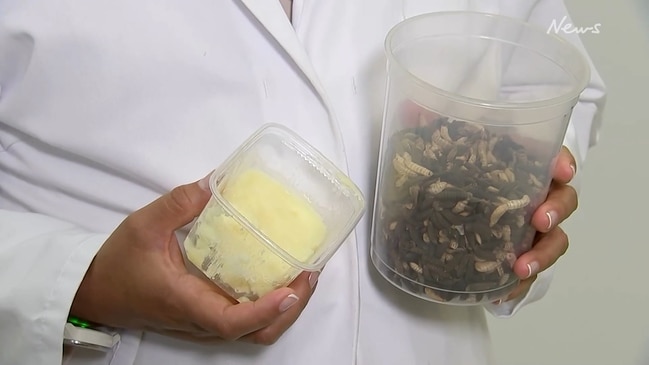Scientists experiment with butter made from insects and it doesn’t taste too bad
Scientists in Belgium are experimenting with larva fat to replace butter in waffles, cakes and cookies, saying using grease from insects is more sustainable than dairy produce

READING LEVEL: GREEN
Would you eat bug butter?
Scientists at Ghent University in Belgium are experimenting with larva fat to replace butter in waffles, cakes and cookies, saying using grease from insects is more sustainable than dairy produce.
To make the bug butter, researchers soak larvae — maggots — from black soldier flies in a bowl of water, put it in a blender to create a smooth greyish dollop and then use a kitchen centrifuge* to separate out insect butter.
“There are several positive things about using insect ingredients,” said Daylan Tzompa Sosa, who oversees the research.
“They are more sustainable because (insects) use less land (than cattle), they are more efficient at converting feed … and they also use less water to produce butter,” Tzompa Sosa said as she held out a freshly baked insect butter cake.
According to the researchers, consumers* notice no difference when a quarter of the milk butter in a cake is replaced with larva fat. However, they report an unusual taste when it gets to fifty-fifty and say they would not want to buy the cake.

Insect food has high levels of protein*, vitamins*, fibre* and minerals* and scientists elsewhere in Europe are looking at it as a more environmentally friendly and cheap alternative to other types of animal products.

GLOSSARY
- centrifuge: an appliance that spins something at high speed so different parts (such as fat and water) separate
- consumers: people who consume, eat, drink or buy
- protein: fuel source that animals need to repair and build body tissue
- vitamins: micronutrients that living things need to function properly. Examples are vitamin C and D
- fibre: part of plant food that can’t be completely broken down by the body; also called roughage
- minerals: pure micronutrients that living things need to function properly. Examples are magnesium and potassium
EXTRA READING
Insects crawling onto Australian menus
World’s most disgusting foods on show
Teen inventor’s big chicken nugget plan
Millions of maggots invade beaches
QUICK QUIZ
- What country is this research from?
- What do they soak the larvae in?
- List three ways insect butter could be more sustainable than regular butter.
- What do people who eat this food say when half the regular butter is replaced?
- What is insect food a good source of?
LISTEN TO THIS STORY
CLASSROOM ACTIVITIES
1. To Bug or not to Bug?
With everybody developing more awareness of their own environmental impact, now would be the perfect time to try and covert people to the idea of bug butter! But it might not be an easy sell!
Read the article carefully to find out all the positive points of substituting bug butter for dairy butter. You may think of some more points of your own. Before being converted to the idea, you may have questions about the process, health benefits or another aspect of it.
Create a table with the headings POSITIVES and QUESTIONS and note down all the positive points of using bug butter and all the questions you may have before you use it.
Time: allow 15 minutes to complete this activity
Curriculum Links: English, Science, Sustainability
2. Extension
Selling Bug Butter
Use your ideas from the above activity to help you come up with an advertisement to sell bug butter. Your advertisement can be for print media, radio or television. You will need to come up with a name for the product, and a strategy for convincing people this product is the way of the future. What points will you highlight? Who will you aim your advertisement at? A catchy phrase or jingle could also be helpful to your advertisement.
Time: allow 30 minutes to complete this activity
Curriculum Links: English, The Arts – Drama, Visual Arts, Media, Science, Sustainability
VCOP ACTIVITY
Use your VCOP skills to highlight all the sentence openers in this article.
Once you have your list, work with a partner to make them into flashcards.
Place the flashcards face up between the two of you and create a new story using a fact or topic idea from the article.
See if you can get through all your flashcards.
HAVE YOUR SAY: Would you eat bug butter?
No one-word answers. Use full sentences to explain your thinking. No comments will be published until approved by editors.

